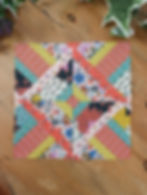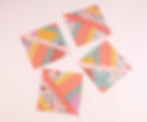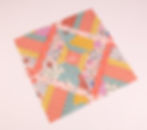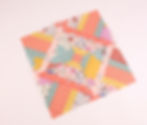Create a Hidden Wells Quilt Block with 7 Strips of Fabric - free sewing tutorial
- Kimberley Hind
- Jul 24, 2025
- 4 min read
Updated: Aug 5, 2025
We’ve made a Hidden Wells block using four fabrics, but this time, we’re switching things up. By changing the strip sizes and using seven fabrics instead, you’ll get a whole new look from the same clever technique. Let’s get into it!
Create a Hidden Wells Quilt Block with 7 Strips of Fabric
If you’re looking for a clever quilt block that looks way more complicated than it actually is, let me introduce you to the Hidden Wells block. It’s one of those magical patchwork techniques where a few simple steps give you a really striking result. You start with seven fabric strips, sew them together into a panel, and with a bit of cutting and rotating, end up with something that looks like you’ve spent hours planning every angle. It’s a brilliant one for using up strips from your stash or playing around with colour and contrast. I’ll take you through the method step-by-step so you can try it yourself.

What You'll Need for One Block:
Seven strips of fabric (see next section for measurements)
Rotary cutter and ruler
Cutting mat
Sewing machine and basic sewing tools
Finished block size is 12.5"
Choosing Your Fabrics
Before you start cutting, it’s a good idea to plan your fabric layout first. The strips are sewn together in an alternating width pattern—1 ½", 2 ½", 1 ½", 2 ½", 1 ½", 2 ½", 1 ½"—so you’ll want to choose the order of your fabrics before you cut anything. Lay your fat quarters or strips out and play around with the arrangement until you’re happy with how the colours and prints flow. Once you’re set, then you can go ahead and cut your strips to size.
You’ll need seven fabric strips in total: cut four strips at 1 ½" wide and three strips at 2 ½" wide, each at least 21" long.
The amount of strips you’ll need overall depends on what you’re making. I’m using a 7 fat quarter bundle to make eight blocks, which is a nice number for a lap quilt or to build on if you want to go bigger. Jelly rolls work well for this too. You can use the 2 ½" strips as they are, and trim a few down to 1 ½" to get the mix you need.
If you’re pulling fabrics from your stash, try to pick a good contrast of lights, mediums and darks so the pattern really stands out once the block is cut and rotated. You want a good contrast between at least a few of the strips, or some of the design might get a bit lost. Think about mixing solids with prints, or balancing busy patterns with calmer ones so your eye has somewhere to rest. You don’t need to overthink it, just lay your strips out next to each other and squint a little to see if anything blends in too much. If it does, swap it out for something with a bit more contrast.
It would also work brilliantly with a jelly roll if you’ve got one you’ve been saving, just grab seven strips and you’re good to go.
For this block, I used a 7 fat quarter bundle I put together for Debbie Shore Sewing. The mix of prints works really nicely for this kind of patchwork, where contrast and colour placement make all the difference. If you're making a whole quilt, you can get around 8 blocks from the bundle.
You can find the bundle here if you fancy using the same one!

Sewing Instructions:
Begin by sewing your seven strips together along the long edges with right sides together. Alternate the widths as planned before, starting with 1.5", then 2.5" and so on. Use a 1/4" seam allowance and press your seams in one direction.

My fabrics are slightly different lengths, so I've lined up the top edges. We will trim this in the next step.
This strip of 7 fabrics sewn should now measure 10" across.
Cut the strip set into two 10" squares.

3. Take one of your 10" squares and rotate it a quarter turn clockwise or anti-clockwise. This will change the strip direction. One block will now have lines running vertically, while the other will remain horizontal.

4. Place the squares right sides together, ensuring that one is still rotated. Sew a 1/4" seam allowance around the entire square.

5. Cut the square diagonally from one corner to the opposite in both directions. This will give you four triangle shapes.

6. Open each triangle and press them. You'll now have four squares measuring 6.5" each. Be sure to trim any tails on the seams for a clean finish.

7. Arrange the four squares. Alternate the direction of the stripes to create a woven or offset effect. There are various layouts you can use, so feel free to experiment.

8. Once you are happy with the arrangement, sew the squares together into two rows of two blocks. After that, sew the rows together to complete your Hidden Wells block!

Finally, give the whole block a good press. You can press seams open or to the side, depending on your preference. If necessary, trim your finished block to square it up neatly.
This is what 8 blocks would look like -

This is what 16 blocks would look like -

Once you’ve made one Hidden Wells block, it’s hard to stop. The way the design reveals itself never gets old, and every block turns out slightly different depending on the fabrics you use. It’s a great technique to keep in your patchwork toolkit, especially when you want a design that looks detailed without being fiddly.
If you give it a try, I’d love to see what you make, feel free to tag me or share your version over on Instagram! @whatkimberleymakes
happy stitching! Kym
